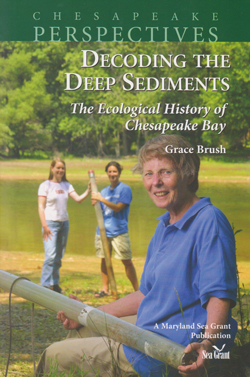
It was once suggested to me that there are two times when most academics might write reviews: as a graduate student, and towards their career’s end, when they show how their lifetime’s work fits into the bigger picture of their field’s developments. In this short book, aimed at members of the public, Grace Brush looks back on her work on the later Holocene of Chesapeake Bay. This paperback spans her life from the mid-1950s, when she was a graduate student at Harvard University, to her ongoing work.
The estuarine Chesapeake Bay has in post-Colonial times been greatly impacted by human activities on the surrounding land. There is little evidence that the small numbers of pre-Colonial Native Americans caused major changes. Thus, when Europeans arrived in the late 17th century, the land was primarily forested. These forests were cleared for cropland, buildings, firewood, roads, and other needs, such that 20% had been cleared by the 18th century, and 80% by the late 19th century. As the land changed, so did the Bay’s estuarine ecosystem.
Grace Brush’s work has included mapping the remnant forest types of the Chesapeake drainage basin (“watershed” in American parlance). She and her co-workers identified 18 forest types using indicator species, and documented these forests’ relationships with rock and soil substrates. This information proved valuable for interpreting palaeoecological studies of the Bay, which incorporated much evidence from pollen and seeds, as well as other microscopic remains. Work on cores documented the extirpation of the American chestnut in the 1930s and of the American elm more recently. These core studies showed also that the increasing flux of nutrients (especially from sewage and fertilizer) led to an increase in the abundance of diatoms, but this was accompanied by a decrease in their diversity. The foraminifera Elphidium, which favours clear water because it obtains nutrients from chloroplasts derived from consumed diatoms, does not occur in post-Colonial sediment. Populations of polychaete worms (documented using their fossilised jaws) declined dramatically, leading to declines in carnivorous fish species.
Brush’s work has contributed to restoration efforts since 1985. This work has been led primarily by appropriate reforestation. It is anticipated that as the water becomes clearer and cleaner, the estuarine ecosystem will gradually reorganise and restore itself.
Brush’s monograph concludes with a chapter on the challenges facing women in palaeocological research. She notes especially the problem of juggling research and childcare (and its costs). One wonders if that situation has changed appreciably nowadays.
Reviewed by Brent Wilson
Decoding the Deep Sediments: The Ecological History of Chesapeake Bay, by Grace Brush, 2017. Published by Maryland Sea Grant College, 72 pp. pbk. ISBN 978-0-943676-76-0,
US Price: $12.95
W: https://ww2.mdsg.umd.edu/store/books/cp/